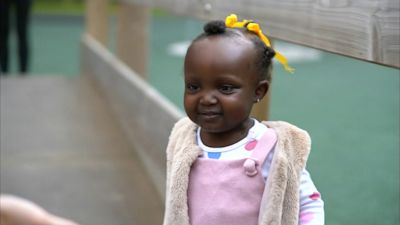Children's hospices in England facing staffing crisis almost twice as severe as NHS

For families of young children with life-limiting conditions, the care they get at hospices is invaluable. But providing that crucial support is getting harder because of a shortage of staff, reports Political Correspondent Daniel Hewitt
Children's hospices are facing a staffing crisis almost twice as severe as the National Health Service, according to figures given ITV News.
There is currently an 18% shortfall in the number of nurses needed to care for the most seriously ill children, compared with a 10.5% vacancy rate for NHS nurses in England.
The research by Together for Short Lives carried out for ITV News shows 58% of hospices facing the most severe staff shortages have already reduced services and respite care.
Amid the cost-of-living crisis, hospices are worried that they'll be unable to raise much-needed funds, says Political Correspondent Daniel Hewitt
“Children’s hospices need professionals with the skills and experience to meet the complex needs of seriously ill children and young people," Andy Fletcher, Chief Executive of Together for Short Lives, said.
"It is therefore very worrying that children’s hospices are struggling to recruit the staff they need to meet these needs.
"It is vital that the government, the NHS and health workforce planners act to urgently boost the number of nurses and other professionals in England who can care for seriously ill children.
"They should also include children’s hospices and other charity services in their workforce planning, just as they do for NHS hospitals and community services.”
The average children's hospice in the UK receives 17% of its funding from government health budgets, for adult's hospices it is 30%. The rest must be raised through fundraising.
It means hospices have to raise millions of pounds every year in donations to fund end-of-life-care.
The vast majority of hospices choose to match NHS salaries for nurses in order to attract workers and remain competitive, but funding wage increases means having to raise more money themselves.
The average age of hospice staff is also older than in the NHS, with 33% of the clinical workforce, which includes nurses, aged over-55 and many nearing retirement.
Hospice UK warn that if action is not taken now to recruit more nursing staff to the hospice sector then more services may have to be cut.
Want a quick and expert briefing on the biggest news stories? Listen to our latest podcasts to find out What You Need To Know
"While hospices are just about managing to maintain services at present, it is requiring herculean efforts, use of temporary staff and adaptation of services, with some hospices sharing staff, especially as, like many professions, staff sickness rates are skyrocketing as people fall ill and take time off with Covid-19," said a Hospice UK spokesperson.
With an ageing population with increasingly complex illnesses, demand for expert palliative care is just set to increase.
The recent amendment to the Health and Care Bill, making it a legal requirement for those who lead our healthcare system to consider people's palliative care needs, is a welcome move, but without more staff to provide the care, the future remains on a knife-edge.
The research by Together for Short Lives for ITV News found:
The average vacancy rate for nurses and other non-medical care and support professionals working at the equivalent of NHS Agenda for Change bands 5-9 (more specialist levels) inclusive has grown to 18.6% in 2022, compared to 12.2% in 2019.
This is higher than the NHS nursing vacancy rate in England in quarter three of 2021/22, which was 10.5%.
Within this, one in four (26%) band 5 posts in children’s hospices are vacant.
Over two thirds (70%) of children’s hospices report higher care and support professional vacancy rates compared to April 2019.
Among those children’s hospices who are experiencing a higher vacancy rate, over half (58%) say that this has led to them cutting or stopping their short breaks for respite for families of seriously ill children.